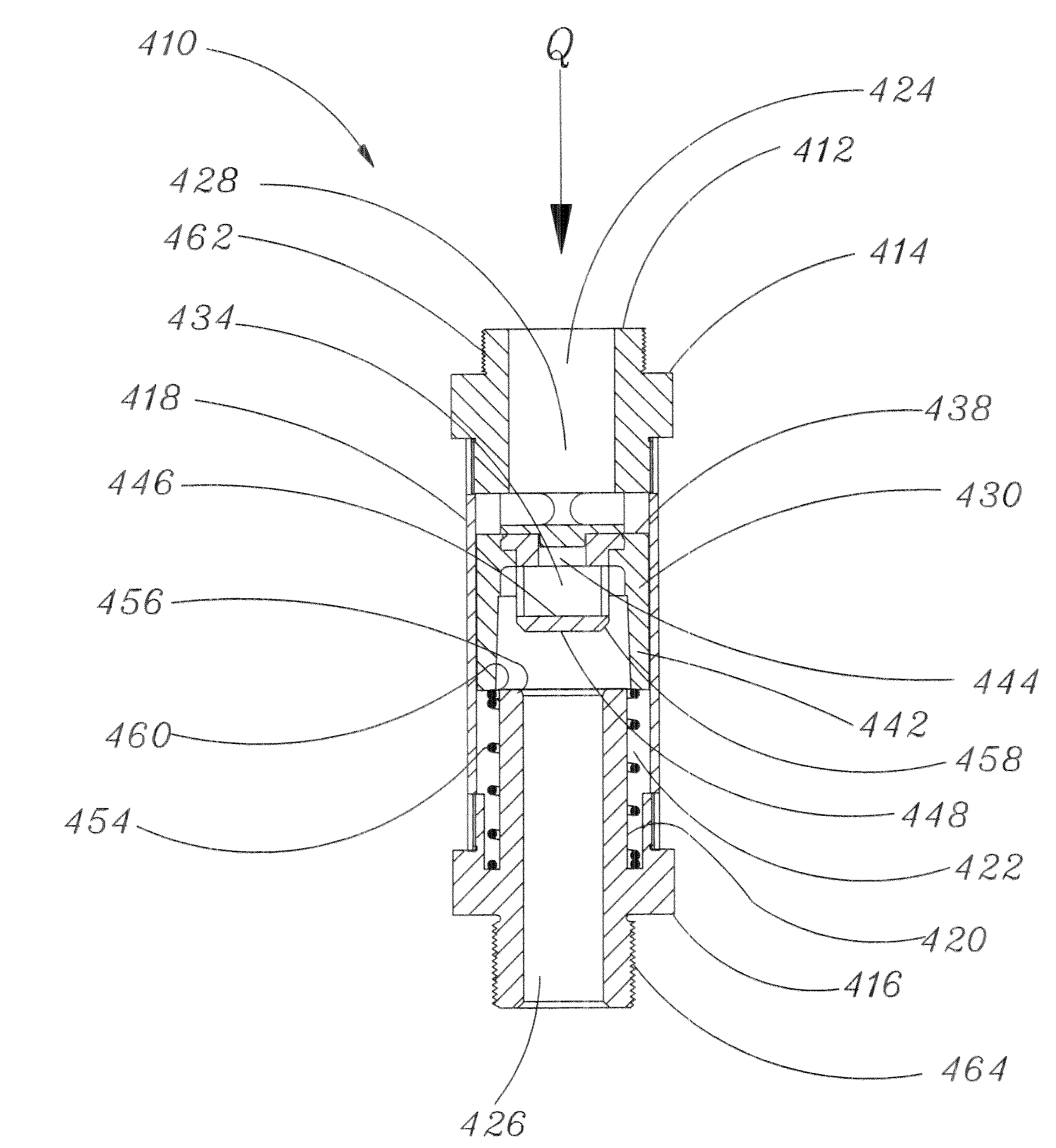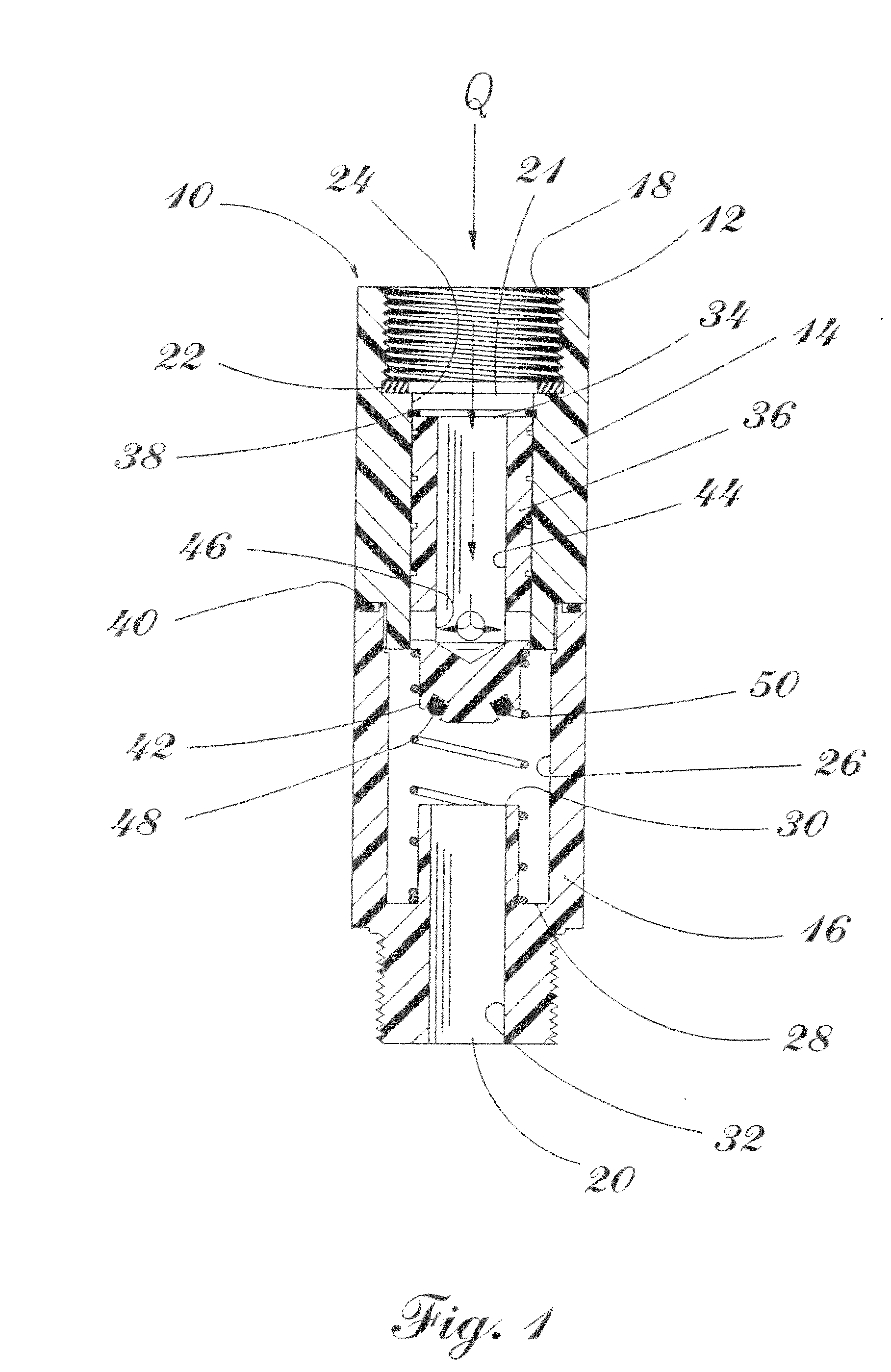Damped, self-cleaning flow shutoff valve and associated methods
a shutoff valve and self-cleaning technology, applied in the direction of valve operating means/releasing devices, functional valve types, transportation and packaging, etc., can solve the problems of inconvenient use of mechanical devices, inconvenient maintenance, and inability to operate properly,
- Summary
- Abstract
- Description
- Claims
- Application Information
AI Technical Summary
Benefits of technology
Problems solved by technology
Method used
Image
Examples
second embodiment
[0017]FIG. 4 is a bottom view of a flow shutoff valve;
[0018]FIG. 5 is a cross-sectional view taken along lines 5-5 of FIG. 4;
[0019]FIG. 6 is a perspective exploded assembly view of flow shutoff valves with an appliance;
[0020]FIG. 7 is a perspective view of a flow shutoff valve with a sprinkler system;
third embodiment
[0021]FIG. 8 is a cross-sectional view taken along the centerline of a flow shutoff valve, in a position with no flow therethrough, for use with a stop valve;
[0022]FIG. 9 is a cross-sectional view of the flow shutoff valve of FIG. 8, in an intermediate position with flow therethrough;
[0023]FIG. 10 is a cross-sectional view of the flow shutoff valve of FIG. 8, in a shutoff position;
[0024]FIG. 11 is a perspective view of a poppet guide having a plurality of metering slots therein held in the housing of the flow shutoff valve of FIG. 8;
[0025]FIG. 12 is a cross-sectional view of the combination flow shutoff valve of FIG. 8 and a stop valve, with the flow shutoff valve, in a position with no flow therethrough;
[0026]FIG. 13 is a side cross-sectional view of another embodiment of the present self-cleaning flow shutoff valve, in a position with no flow therethrough;
[0027]FIG. 14 is a side cross-sectional view of the self-cleaning flow shutoff valve of FIG. 13, in a normal flow position;
[002...
first embodiment
[0051]To accommodate the motion damper 52, the housing 12 includes an insert 60, centrally defining the cavity 54, with multiple ports 62 thereabout. The ports are substantially larger in cumulative cross-section than the orifices 46. This allows a rapid drop in pressure below the valve element 34 with resulting closure of the shutoff valve 51 when pressure at the outlet 20 drops to near zero gauge. The insert 60 may be press fit or retained by bonding. A further variation from the first embodiment may be the employment of slip sockets, as the shutoff valve 51 is depicted in FIG. 7, particularly adaptable with PVC, CPVC and ABS type piping systems for bonding of the system components to the valve 51.
[0052]FIG. 6 illustrates the use of flow shutoff valves 10 with a home appliance such as a washing machine 66. Flexible hoses 68, 70 are coupled with the flow shutoff valves 10 which are in turn coupled with the standard manual valves 64, 72. In the circumstance that a flexible hose 68, ...
PUM
 Login to View More
Login to View More Abstract
Description
Claims
Application Information
 Login to View More
Login to View More - Generate Ideas
- Intellectual Property
- Life Sciences
- Materials
- Tech Scout
- Unparalleled Data Quality
- Higher Quality Content
- 60% Fewer Hallucinations
Browse by: Latest US Patents, China's latest patents, Technical Efficacy Thesaurus, Application Domain, Technology Topic, Popular Technical Reports.
© 2025 PatSnap. All rights reserved.Legal|Privacy policy|Modern Slavery Act Transparency Statement|Sitemap|About US| Contact US: help@patsnap.com



